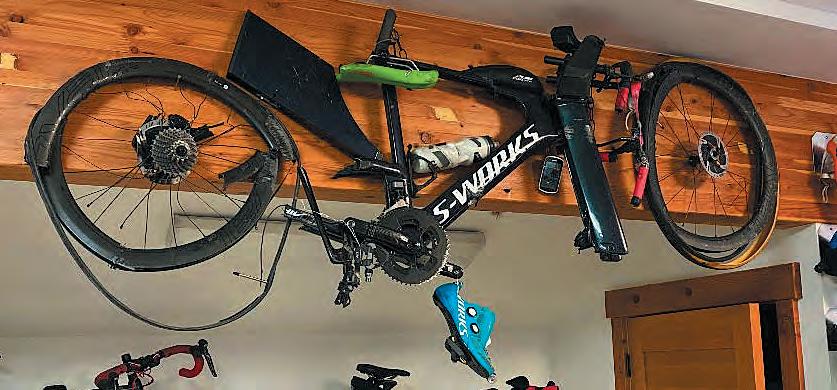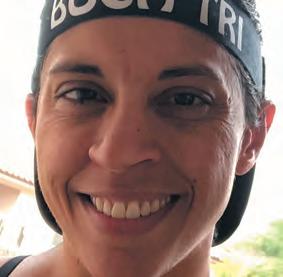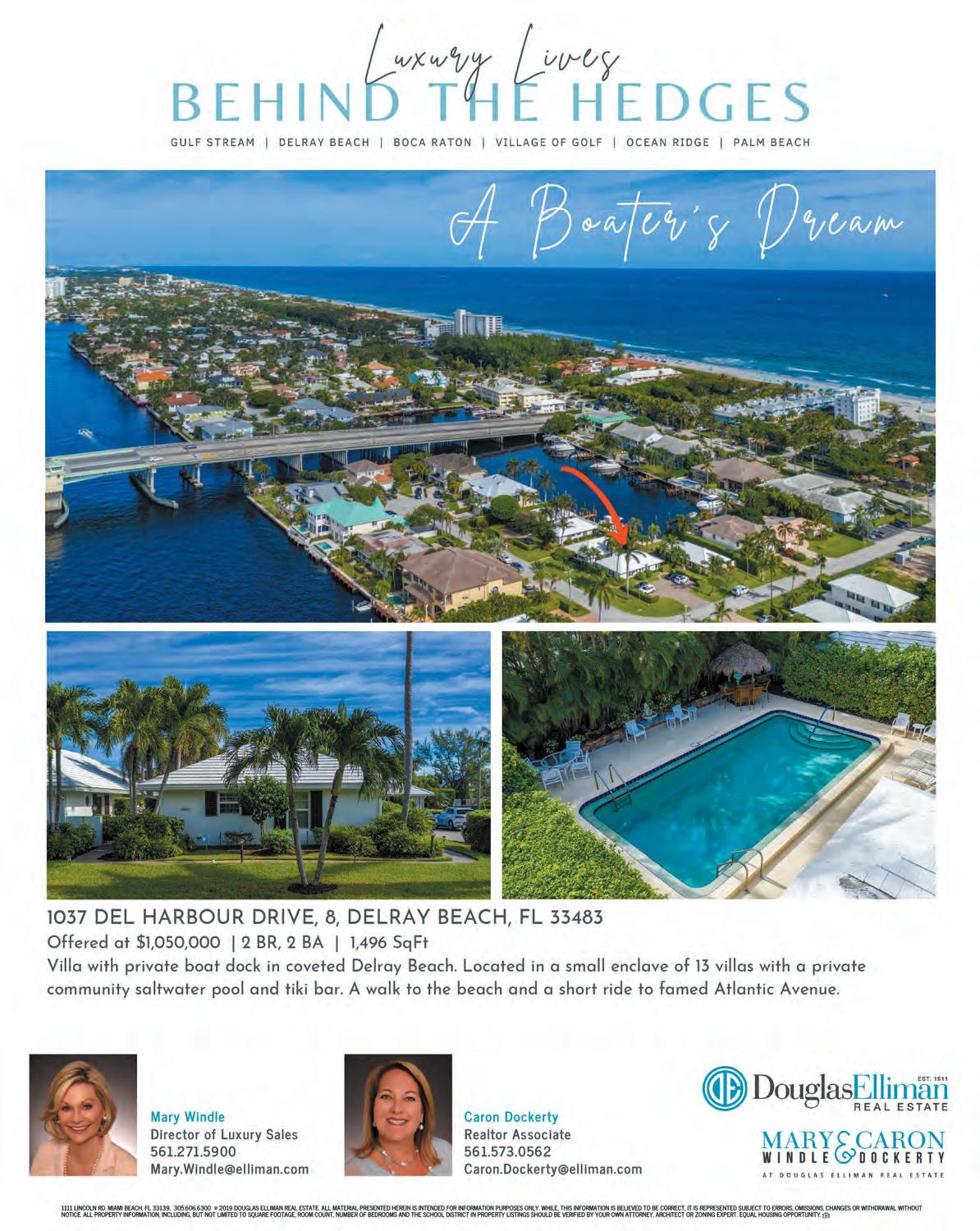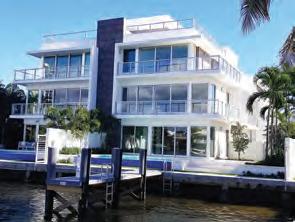
38 minute read
See BICYCLES on
Continued from page 1 snapped a photo of Barry sitting on the curb after he regained consciousness, his legs black and bloody, a slight grin on his face.
When Barry came to, he looked at his legs and saw gashes with exposed bone and shredded muscle.
“It wasn’t pretty,’’ said Barry, who had his football-damaged knees replaced in 2013.
“As I got thrown off the bike, my pedal and shoe stayed on my foot and separated from the bike. The whole frame was broken in half and there were ragged pieces of carbon everywhere. My legs got sliced and diced on the inside because as I went off the bike I must have hit these carbon pieces that were split sideways.’’
The driver of the 1995 Cherokee, an 80-year-old Briny Breezes man, tried to leave the scene, but Barry’s companions blocked his vehicle with their bikes until police arrived.
He was cited for careless driving that day, Feb. 11, 2020. He said he was headed south at 5 p.m. “behind a large line of vehicles when he suddenly heard a thud on the side of his car,’’ according to a Manalapan police report.
He pleaded not guilty. That summer, a judge dismissed the case because the officer who issued the citation failed to attend the driver’s traffic infraction trial, which was held on Zoom, court records show.
By then, Barry was in Big Sky, Montana, going through grueling physical therapy sessions that helped him regain his strength after his wounds were closed with 400 staples and 300 stitches.
“I won’t go back onto the road,’’ said Barry, who mounted the mangled pieces of the bike on the wall of his garage as a reminder. “It’s not worth the risk.”
A1A seen as dangerous
Avid cyclists like Barry have long known that Palm Beach County, in particular the scenic coastal stretches of A1A, can be a dangerous place to ride. But recent statistics show a disturbing trend in fatalities.
Eleven bicyclists were killed in 2020, more than double the number of such fatalities recorded in 2019, according to the Florida Department of Highway Safety and Motor Vehicles.
And with three fatalities through March, the county had been on pace to exceed 2020’s deadly toll. There were no fatalities in April and none through late May.
Legislation awaiting Gov. Ron DeSantis’ signature may help keep those numbers down. If signed, the proposed law set to go into effect on July 1 will add several safety initiatives, including a requirement for drivers to stay behind bicyclists if there’s no room to pass.
The rise in bicyclist as well as pedestrian deaths is probably part of a national trend related to the coronavirus pandemic.
“You have a lot more people that are using bicycling and walking as their escape from the pandemic lockup,” said Ocean Ridge Police Chief Hal Hutchins. “When you put more folks on the roadways, it becomes more important for everyone to be careful and follow the rules.’’
But following the rules is not something drivers and bicyclists do on a consistent basis.
Though bicyclists and pedestrians represent just 2% of commuters in Palm Beach County, they made up 30% of all transportation-related fatalities on county roadways from 20182020, according to the Palm Beach Transportation Planning Agency.
“These are our most vulnerable users and they’re a large, disproportionate share of the total fatalities,’’ Andrew Uhlir, the agency’s director of program development, said at a TPA governing board meeting in February.
“We are not heading in the correct direction when it comes to safety.’’
Among the deadliest states for bicyclists, Florida has consistently ranked at or near the top. In 2019, Florida’s 161 bicycle deaths were the highest in the nation, 28 more than No. 2 California had.
In Palm Beach County, a 2017 Pedestrian and Bicycle Safety Study by the Palm Beach TPA identified 10 “high-crash corridors.’’ Only one was an area frequented by road cyclists — Ocean Boulevard from Thomas Street (just north of Atlantic Avenue) to Linton Boulevard in Delray Beach.
The other nine “high-crash corridors” were in areas where people ride on generally slower bikes.
Riders can be at fault
It’s not always the motorist’s fault.
Bicyclists don’t always wear proper safety gear and don’t always obey traffic laws, taking chances by crossing busy streets against red lights.
“A lot of it we see is no helmet, safety gear missing, no lights at night. Improper clothing, the color of clothing when you ride your bike and dusk or dawn hours,’’ Delray Beach police Sgt. Hannes Schoeferle said.
And on State Road A1A, cyclists sometimes ride in packs, taking up the travel lane. This can happen even if they abide by the law and ride no more than two abreast.
In South County, Delray Beach and Boca Raton have designated bike lanes on A1A, whereas other municipalities have only shoulders of varying widths. The Gulf Stream and Manalapan shoulders are the narrowest.
“Right or wrong — wrong, obviously — at some point the motorist is really getting worked up,’’ Schoeferle said. “It’s an emotional issue, and they’re going to start passing in a reckless manner. This is when we see crashes.’’
In Ocean Ridge, town officials included in a May newsletter for residents a list of bike safety tips in observance of National Bike Month.
“It is incumbent on all of them to do their part to share what’s available for safe travel and according to the law,’’ Chief Hutchins said.
“Are the bicycle packs of particular concern? I would say some of them are. But so are motorists who don’t follow the rules of the road pertaining to sharing the traffic ways with bicyclists.’’
Many bike clubs remind their members about the rules and how cyclists are supposed to Road design a problem
A big problem is the fact that just about all roads were designed for motor vehicles, not for cyclists.
On most parts of A1A, the predominant place for road cyclists on the barrier island, there are no bike lanes. Cyclists are forced to ride on the shoulder, potentially inches from motor vehicles and often over hazards such as sewer holes and traffic reflectors.
“The road is just not built for cyclists,’’ said Kristy Breslaw of Boca Raton Triathletes. “There is a lot of distracted driving. There’s a lot of people not paying attention when they’re driving.’’
Cut off suddenly
On the morning of July 6, 2018, Sandra Prestia was enjoying “a beautiful ride” as she pedaled south on State Road A1A in Manalapan.
Without warning, a white construction van heading north turned in front of her to enter a condo building on the west side of the road.
“I saw white and then I was in an ambulance,’’ said Prestia, a triathlete who has been riding competitively for 11 years.
The impact snapped her bike in two, but that wasn’t the only damage.
“I T-boned him. It was like my face made an imprint in the van,’’ said Prestia, 41, who was rushed to Delray Medical Center with a concussion.
“My top lip was in three pieces. A plastic surgeon had to sew my lip back together. I had bruises on my knees and legs for at least six months.’’
She didn’t break any bones. But the crash resulted in $70,000 in medical bills, most of it paid by her insurance.
The driver of the van stopped to offer help and, according to what the police told Prestia, “he apologized profusely.’’
Still, she can’t understand how he didn’t see her.
“It was 8 a.m. The roads were completely empty,’’ she said. “There was nothing to take his attention away and not to see me. He just turned in front of me.’’
Six weeks later, she was back on her bike.
“Am I overly cautious now? Oh, yeah,’’ she said. “But to stop doing what I love, cycling, I don’t want to live like that.’’
Rules to change in July
Florida bicyclists will get some added layers of protection in the form of safety changes expected to become law in July.
A bill approved by lawmakers in the recent session would require drivers to change lanes when approaching a bicyclist or pedestrian in the travel lane and, if they cannot safely change lanes, wait at a safe distance behind the bicyclist or pedestrian until there is room to pass.
The current law, section 316.803 of the Florida Statutes, requires drivers to be at least 3 feet from a cyclist when passing, but it makes no provisions for waiting if there’s no room to pass. Safety advocates note that few roads in Florida are wide enough for drivers to obey the 3-foot rule, which is why drivers often ignore it and pass dangerously close to cyclists.
The new law — sponsored by Sen. Lauren Book, D-Plantation, with a companion bill sponsored by state Rep. Christine Hunschofsky, D-Parkland — has an educational aspect. The Department of Highway Safety and Motor Vehicles will be required to launch a public awareness campaign informing motorists about required safety precautions when passing bikes and pedestrians.
The department also will have to include the precautions in driver’s license educational materials and to devote 20% of the questions for the driver’s license tests to bicycle and pedestrian safety.
“This legislation is probably some of the most progressive we have seen,’’ said George C. Palaidis, a Plantation-based attorney and avid bicyclist who often rides from Key Biscayne to Palm Beach.
“For the first time there is a definition of a bicycle lane in the statutes. And the educational aspect of it is huge. There’s still a lot of work that needs to be done but it’s a giant step in the right direction.’’
A similar incident
Pedaling north on A1A with another cyclist, Rhonda Wright saw a white car pass them.
“I was in the lead position,” recalled Wright, who was about a mile south of the Lake Worth Beach pier on the morning of July 7, 2019.
“And he just turned straight in front of me to go into a driveway.’’
With nowhere to go, Wright slammed the brakes. “I tried to pull my bike down to the right to get out of his way and I went straight into the side of him,’’ she said.
Her bike’s aero bars — an extension mounted close to the center of the handlebar that cantilevers out over the front of the wheel — got caught under the car’s front wheel. Wright was dragged 25 feet across the asphalt before the car stopped.
“My left arm got dragged along the side and I was half underneath his car. I turned onto my bike and thought, ‘I’ve got to get out of here.’ As I flipped myself around, my hand got caught under the car.’’
Her right hand was broken. Her left shoulder dislocated and the labrum was torn. Her helmet was smashed.
“My broken helmet saved me from severe head trauma,’’ said Wright, 66.
She missed two months of work as a home health care aide. She had hand surgery and racked up close to $80,000 in medical bills.
“I can’t hold weights and things like I used to because I have permanent screws and pins in my hand,’’ she said.
She said the driver, “an elderly guy” who worked as
Almost like a trophy, Steve Barry kept the battered remains of his bike after the accident. Photos provided
Sandra Prestia, the day of her accident, and after she healed.
Rhonda Wright’s helmet was broken in her accident, saving her from head trauma.



a condo security guard, was cited for reckless driving.
“He said he didn’t see us. He was probably in his 80s and I don’t think his peripheral vision was very good,’’ Wright said.
Wright, a triathlete who lives in Boca Raton, still rides competitively but only in races where the roads are closed to motorists.
“I will not ride on A1A because it’s not safe,’’ she said. “You have people out there who have no respect for bikers at all. It’s really a sin.’’
Vision Zero: Safety for all
The Palm Beach Transportation Planning Agency is working on ways to protect bicyclists and pedestrians. For one, most new roads in the county are now built with bike lanes.
The Florida Department of Transportation led with changes to its design manual for state roads in the early 2010s and Palm Beach County followed, including bike lanes in its county roadway standards in 2018.
“The TPA Board has also adopted a Complete Streets Policy and a Vision Zero commitment to ensure that all transportation projects funded by the TPA include safe and comfortable facilities for transportation users of all ages and abilities,’’ said TPA Executive Director Nick Uhren.
But more needs to be done, said Robert Weinroth, the Palm Beach County Commission’s vice mayor whose district includes the coastal communities from South Palm Beach to Boca Raton.
He called on local leaders to take “a more proactive approach” aimed at preventing bike and pedestrian accidents, similar to the intense focus investigators give to airline crashes.
“We know statistics don’t fully represent the pain that’s being inflicted on the victims and families of these tragic events,’’ Weinroth said at a recent TPA governing board meeting.
“We need to drill down into these incidents to figure out what it is that is common about these accidents that are causing the carnage on our roadways and what can we do in fixes rather than just continually look at the wrong direction of these trends.’’
Death is a cautionary tale
Steve Brown loved his family, his friends and his bicycle.
He enjoyed back-road biking adventures with his wife, Dana, and riding around his Boca Raton neighborhood and to the beach for exercise. And as the affable co-founder of Brown’s Interiors, he took any opportunity he could to leave the car at home and pedal to a client’s house with a swatch or sample. On the morning of April 9, 2014, Brown strapped on his bike helmet and set off to see another client. He was bicycling north on the shoulder of Lyons Road around 9 a.m. when a 68-year-old woman driving a minivan lost control and struck Brown from behind. Brown hit the windshield and was thrown onto the sidewalk. He was pronounced dead at the scene, less than 3 miles from home. He was 58.
More than 1,500 people attended his funeral. His death inspired congregants at Temple Beth El in Boca Raton to launch an annual charity bike ride in his memory.
But seven years later, his family remains scarred from the tragedy.
“It affects us every day,’’ said Andrew Brown, a son. “He was head of the family. Head of the business. My mom and him had been happily married for many, many years. They were high school and college sweethearts. My sister was pregnant at the time of the accident, so he never got to see his first grandchild. It was devastating on the family.’’
The driver, Marion Rosenstein, pleaded no contest and was found guilty of unlawfully overtaking and passing a vehicle. Her driver’s license was permanently revoked and she was ordered to complete 120 hours of community service.
In 2011, Rosenstein was cited for running a red light and causing a crash, court records show.
“South Florida can be a hard place to live because it’s so beautiful and you want to bike all day every day, but it’s just … these cars,’’ said Susan Brown Siegel, a daughter.
“I just can’t handle distracted drivers on the road,’’ she continued. “Listen, I know every single person checks their cellphones, but you never think it’s going to be you. I never thought it would happen to my dad. He rode his bike but he wasn’t one of those cyclists on A1A. It was just awful.’’
Brown’s family has been speaking out about the need for better safety measures such as more dedicated bike lanes or even barriers separating cars from bikes.
As for the trend of bicycle fatalities, the Brown family is not surprised.
“The numbers will keep going up because not enough preventive action is being taken and more and more people are using bicycles, especially during the pandemic,’’ said Andrew Brown.
“Unless measures are taken on the safety prevention side, the numbers are going to keep going up. There’s just no way around that.’’ Ú
Local Voices
Manatees are starving to death, but Florida doesn’t seem to care
In the first four months of 2021, deaths reached 723; in all of 2020, 637 died in the state. There’s not enough sea grass to support all of them
We love manatees in Florida.
We put them on license plates. We name our school mascots after them. We brag about the beloved sea cows to out-of-state friends.
But Florida’s decisionmakers aren’t showing the love, putting economic interest over the preservation of manatee habitats. They have allowed urban development to spread without enough safeguards, defunded environmental agencies and imposed waterquality standards that are friendly to polluters. And even when those standards are stringent enough, Florida has failed to enforce them.
“Now the bills are coming due,” Patrick Rose, executive director of the Save the Manatee Club, told the Miami Herald’s Editorial Board.
We’re paying a high price.
Manatee deaths in 2021 have reached such an alarming number in Florida that the federal government declared it an “unusual mortality event.” In the first four months of the year, manatee deaths reached 723, surpassing the 637 deaths reported in all of 2020 and the 607 reported in 2019, according to the Florida Fish and Wildlife Conservation Commission.
The cause of death in most cases is unknown because necropsies were done on only one-quarter of them, Rose said. But the available data shows that many died from a combination of cold winter temperatures and starvation.
Freshwater springs were historically a warm-water refuge for manatees during the winter, but most have either been blocked by dams, altered by construction or are subject to declining water levels because of groundwater pumping for human or agricultural use. That has caused manatees to migrate to power plants along Florida’s east coast for warm water during cold months.
Shrinking habitat
There is not enough sea grass to feed them in those spots because of the toxic algae blooms that have plagued our rivers, bays and lakes. Nutrients found in fertilizer, septic tanks, sewage spills and urban runoff are feeding those blooms.
Florida’s environmental disasters have been decades in the making, and it took several governors and legislatures to get us to where we are. But never was there as much disregard for natural resources as during former Gov. Rick Scott’s tenure from 2011 to 2019, Rose said.
“Those eight years were terrible years for Florida,” he told the Herald board.
Scott made it easier for businesses to obtain environmental permits at the expense of water quality; he pushed out experienced scientists from the Department of Environmental Protection and, to add insult to injury, forbade them from using the term “climate change” in official communications.
He dismantled the Department of Community Affairs, which oversaw urban development — and he got help from the Legislature’s chipping away at growthmanagement laws. Scott also imposed drastic budget cuts on water management districts, which oversee many restoration projects. Many of these cuts were necessary during the Great Recession, but the state didn’t recover from them even as the economy rebounded.
Scott, now a U.S. senator, isn’t the only culprit. Lawmakers have done their share by siding with powerful industries such as agriculture, which has fought stricter water quality standards and enforcement.
DeSantis raises hopes
Environmentalists are more optimistic about Gov. Ron DeSantis. He appointed a chief science officer and created an algae-bloom task force, but it can only make recommendations. The DEP, which answers to the governor, has resisted calls to create water quality criteria for the bacteria that’s in algal blooms. That’s an irresponsible failure that DEP should correct.
Let’s not forget the role of cities, counties and utilities.
Broward County has the second-largest number of manatee deaths — 56 — which is three times more than last year. Broward is home to a Florida Power & Light power plant and has seen several sewage spills in recent years. Boating also played a role in manatee deaths there.
More than half of all manatee deaths in the first four months of 2021 occurred in the Indian River Lagoon, the 156-mile estuary that stretches along the Treasure and Space coasts. The lagoon’s northern portion, which accounts for nearly 300 deaths, has lost 60% to 90% of sea grass thanks to urban pollution and leaky septic tanks, Rose said. The lagoon’s southern tip in Stuart gets hit every year by Lake Okeechobee discharges, which carry agricultural pollution that’s behind putrid, guacamole-thick algal blooms.
Similar issues are plaguing Biscayne Bay, which had a fish-kill last year, but MiamiDade hasn’t been a spot where manatees normally congregate in the winter. The county had 18 manatee deaths through April this year.
Rose said manatee deaths could reach 1,000 by the end of the year. The alarming loss of Florida’s most beloved mammal should serve as a warning that the state needs to do better by its natural resources.

— Miami Herald Editorial Board

The board is a group of opinion journalists who operate separately from the Miami Herald newsroom. “The Invading Sea” is the opinion arm of the Florida Climate Reporting Network, a collaborative of news organizations across the state focusing on the threats posed by the warming climate.

By Mary Hladky
Boca Raton City Manager Leif Ahnell has warned council members that the city faces a potential $20 million budget deficit in two years.
Of most concern is that revenue the city gets annually from the Community Redevelopment Agency is about to dry up.
The city will receive $13 million from the CRA this year. By the 2023-24 fiscal year, the CRA will no longer make payments to the city. The CRA is scheduled to cease to exist in 2025.
The relationship between the city and its CRA, which was created in 1980 to eradicate downtown blight, is complicated. But for budget purposes, the CRA is required by state law to reimburse the city for the cost of police, fire and other city services in the downtown.
Another issue is police and fire pension costs. Ahnell told council members on April 26 and again at a council goalsetting session on May 12 that the pension plan’s investment returns are underperforming the market significantly.
The pension plan was expected to earn an 8.6% return last year, but realized 4.1%. The previous year, a 4% return was expected, but it earned 3%. The underperformance is expected to continue, he said.
“The firefighters and police are very concerned about it,” Ahnell said.
It also appears that the police and fire pension fund’s management and consulting fees are “significantly greater” than those of other pension funds, he said.
The city soon will spend $2.4 million to shore up the fund.
The pension plans for the city’s general employees and executive staff do not pose a similarly high drain on the city’s budget.
“We cannot continue to absorb these kinds of shortfalls,” Ahnell said. “It will become a challenge to balance next year’s budget.”
The pension board has eight members, with four appointed by the City Council. Police officers and firefighters each appoint two members. The Coastal Star was unable to reach a pension board official.
While the city makes appointments, it has no other control over how the board operates or invests its money.
The potential deficit doesn’t mean the city is going broke. It can cut spending or raise taxes to balance the budget. But the city is very proud of its low tax rate, so a tax hike seems very unlikely.
Ahnell cautioned council members to be mindful of the potential deficit as they make spending decisions.
The city is growing and so needs to increase services such as police and fire protection. As it adds new parks, it must hire new employees. The city also will bear the expense of pending projects, including the construction of the new Wildflower/Silver Palm Park, building a parking garage for the Brightline station and taking over the operations of the Boca Raton Golf and Tennis Country Club that was donated to the city.
Planning for a new government campus has been placed on hold because of the pandemic, but at some point the city will replace the aging and outdated police department and City Hall buildings. Ú
Police, fire pensions straining city’s budget
Highland Beach Town settles lawsuit over boat lift
By Rich Pollack
Highland Beach commissioners have reluctantly agreed to settle a lawsuit stemming from actions by the town’s planning board dating back to 2017 and involving the height of boat lift pilings.
As part of the settlement, the owner of waterfront property agrees to reduce the height of 10 wood pilings from 12 feet high to 7 feet and the town agrees not to enforce its contention that the pilings should be no more than 4 feet tall.
In addition, the property owner, 1006 Grand Court LLC and Richard Touchette also agree to pay $2,500 for the town’s legal fees.
At a meeting last month, town commissioners voted 4-1 to approve the settlement with Commissioner Evalyn David casting the no vote.
Even the commissioners who voted to approve the settlement did so with reservations, understanding that some residents in the Boca Highland Beach Club and Marina fear the loss of their view should a large boat be placed on the lift.
In voting against a settlement, David said she thinks it sends a wrong message to the community.
“We need to say you can’t interfere with the quiet and enjoyment of someone else’s property,” she said
Mayor Doug Hillman, who like David lives in the Boca Highland community, noted that the property owner will be cutting 5 feet off the current pilings, which will then be just 3 feet higher than the town’s request.
“It’s not perfect but we don’t live in a perfect world,” he said. “Compromises have to be made.”
Hillman and Vice Mayor Natasha Moore used the case to re-emphasize the importance of town boards’ doing due diligence before making decisions.
“The proper research has to be done before a vote comes to the board,” Hillman said.
In the case of 1006 Grand Court, the town’s planning board twice approved the project as early as 2017, but the town’s building department stopped construction from continuing once 12-foot-tall pilings were installed.
When the property owner came back to the planning board and asked to be allowed to keep the pilings at 12 feet, the request was denied.
The planning board later denied the owner’s request to have the pilings at 7 feet, which led to an appeal to Palm Beach County Circuit Court.
In court filings, the lawyer for the property owners said part of the problem is that the town code addresses the height of dock pilings but not boat-lift pilings.
“The confusion arose because the initial application showed four-foot pilings for the dock which the town assumed also applied to the pilings for the boat lift,” attorney Scott Weires wrote.
Town Manager Marshall Labadie said that part of the problem was that the town, which has a full-time planner on staff now, did not have one at the time.
“This should have been caught but it wasn’t,” he said.
The town is in the process of amending the code to address the height of boat-lift pilings, he said.
“This is an unfortunate circumstance,” Commissioner John Shoemaker said. “It shouldn’t have happened but it did.” Ú

Anti-religion group wants Nativity, menorah display scrapped
By Rich Pollack
Highland Beach’s Nativity scene — stationed on the front lawn of Town Hall during the holidays — could be history.
A nearby large menorah could also be banished should the town follow the request of a national organization that argues for the separation of church and state.
“We’re being pushed to remove any religious symbols from town property,” said Highland Beach Town Manager Marshall Labadie.
No decision has been made regarding what will be in front of Town Hall come the holiday season, but town officials say their options may be limited because of precedents set in previous court cases.
“It really comes down to what the commission and the community wants,” Labadie said.
The question of whether Highland Beach can have a Nativity scene on town property was raised in February when the Wisconsinbased Freedom From Religion Foundation sent a letter to Mayor Doug Hillman requesting that the town remove it.
“A local Highland Beach resident reported that during this past winter season the town of Highland Beach’s municipal complex had a nativity scene on the front lawn,” the nonprofit organization’s staff attorney Chris Line wrote.
Unaware that the town also had a menorah on the property at the same time, Line wrote that it is “unlawful for the town of Highland Beach to maintain, erect or host a holiday display that consists solely of a nativity scene thus singling out, showing preference for and endorsing one religion.”
Reached last month, Line said his organization of 35,000 agnostics and atheists would have an issue even with the menorah on the property because the town would still be singling out specific religions and endorsing religion as opposed to non-religion.
An option for the town, he said, could be to keep the menorah and the Nativity scene but then allow all religions to have symbols on town property.
That could be a thorny issue for the town and may not be a practical option, Labadie said, in part because of space.
Line said the town would be wise to just remove the Nativity and menorah rather than trying to accommodate all religions.
“It’s much easier if the government doesn’t get involved in putting up religious displays,” he said.
Highland Beach is still studying options, but Line said the town could face legal action from his organization if it continues to have the Nativity and menorah on the lawn.
“It’s definitely an issue that could be litigated,” he said.
Labadie said the town’s Nativity scene had been lent to nearby St. Lucy Catholic Church in the past but was returned in recent years after the church purchased a new one. He said the town could consider offering the scene to the church.
He said the town could also consider modifying an agreement it has with the company that provides the menorah on a lease-to-own basis.
Highland Beach would still have a robust holiday display at Town Hall, he said, that would include lights and a decorated tree. Ú

Highland Beach Town is well prepared to start fire department, leaders say
By Rich Pollack
receiving fire and rescue service million to $10 million but says the station will operate on a day- contracting with another from Delray Beach, which that it will save about $2 million to-day basis. government agency wasn’t
As Highland Beach leaders will come within three years, a year in operational costs. “We’re in a life-safety feasible. methodically move toward Highland Beach has a Town Hillman and Labadie don’t relationship and we don’t have Recognizing there may be starting a town-operated fire Commission and management underestimate the challenges the ability to manage the system some truth in comments from department, they know that team that is already overseeing of starting a fire-rescue more efficiently to meet our skeptics who say Highland some skeptics believe they might an 18-person police department, department — something residents’ service needs and Beach leaders “don’t know what be in over their heads. a 10-person water treatment that hasn’t happened in Palm demands,” Labadie said. they don’t know,” the town has
Their message back: Don’t plant, a full-service library and a Beach County for at least three Resident John Ross, a former set out to hire experts to help underestimate us. small contract post office. decades. Town Commission candidate with the transition.
“I think people will be That’s in addition to a town Still, they say that providing and the author of a blog that During a meeting last month, surprised by where Highland clerk’s office, a public works many services that most other comments on the town’s Labadie detailed a time line of Beach is now compared to where department and the building small towns contract out gives operations, says that Highland steps to be taken as the town we were before,” says Town and finance departments. Highland Beach an edge as well Beach’s lack of a seat at the table moves forward. Manager Marshall Labadie. The town also has a strong as additional independence. with Delray affects the overall He said the town has already In the past financial position, with a fairly “The addition of a fire-rescue town operations. moved ahead with hiring a 21/2 years, he low tax rate and about $6.1 department, although more “The amount of money medical director, a forensic says, Highland million — or about 52% of the complex, will be yet another Highland Beach pays to Delray accountant and possibly a Beach has shed annual budget — in unrestricted addition to our self-governance,” is entirely up to Delray, and that marketing and public relations any remnants reserves. Hillman said. impacts what Highland Beach firm to help craft a branding of its reputation “We’re in the process The ability to control the can spend on other things,” and messaging plan. as a sleepy of becoming a full-service operations of a fire department Ross said. “The choice of where Commissioners agreed that Labadie small town with simple solutions community with growing expectations from our was one of the factors involved in the town’s decision to break to spend the money is the definition of sovereignty.” public education is one of the highest priorities, along with to simple problems. residents,” Labadie said. away from Delray Beach. Cost In previous comments, hiring a local fire consultant and
Labadie, who almost three Labadie and Mayor Doug savings and improved efficiency, Delray Beach Mayor Shelly a fire chief. years ago came to Highland Hillman say those factors — Hillman says, were always the Petrolia said that Highland The education component Beach from Michigan with and the town’s ownership of a driving factors. Beach is a customer of her city is critical, Hillman said, since an extensive knowledge of fire station, a truck and a rescue Under the current contract, and is treated like a customer of the town will be going to voters municipal management, has vehicle — put Highland Beach Highland Beach covers the cost a business. in November to get funding overseen the growth of the in better position than most of 22.5 personnel assigned to the “You don’t get to come to the authorization because the town’s governmental operation, towns to start its own fire-rescue fire station in town but has no board of directors and tell them project exceeds the town’s which includes 48 full-time and department. say in how much Delray Beach how to run the company,” she $350,000 spending cap. several part-time employees. “We continue to find pays its firefighters. said. Labadie said that as the town
Since his arrival, the town has ourselves showing we are unique Each year, Delray Beach gives Ross and others counter that continues to move forward it brought its building department in this county,” Labadie said. Highland Beach a bill for the customers of private companies will keep its focus on the needs in-house, has added a full-time The town estimates that fire service it provides, with can do business elsewhere. For of the residents. planner and has upgraded its transitioning to its own fire Highland Beach having little or Highland Beach commissioners “Public safety is at the finance department. department will include no input in how much that bill the choices were limited, forefront of every decision we
As it breaks away from implementation costs of $8 will be or how the firefighters in especially after they discovered make,” he said. Ú
Ocean Ridge
Election discord devolves into bickering about seat on a minor board
By Dan Moffett
The hard feelings and divisions that grew out of the March election are festering within the Ocean Ridge Town Commission.
During a contentious and sometimes angry threehour meeting on May 3, the commission fought over filling a seat on the town’s Board of Adjustment — in other times, an obscure panel most residents don’t know exists.
The issue arose from a lastminute withdrawal by Polly Joa for a regular position on the board. After Joa withdrew April 21, Carolyn Cassidy applied for the unexpected opening.
Ultimately Cassidy and Robert Sloat were appointed unanimously to the five-member panel, which is charged with resolving code disputes between the town and residents.
But in discussions beforehand some commissioners saw political meddling. Cassidy missed unseating Kristine de Haseth by 16 votes in the election and is an ally of two commissioners, Steve Coz and Geoff Pugh.
“The time line is critical,” said Commissioner Martin Wiescholek, a supporter of de Haseth, the mayor. “That all happened on the very, very last day, within hours of the deadline.”
Wiescholek said it had the look of “backroom dealing.” He proposed taking the seldomused step of suspending the town’s rules and filling the board seat by promoting an alternate.
Coz and Pugh, both former mayors, vehemently protested against suspending rules and said Cassidy should get the seat.
“I’ve been on the commission for years and I’ve never seen a moment like this,” Coz said, arguing it was ill-advised to circumvent the rules.
Pugh called the idea of overriding procedures and rejecting Cassidy “wrong and wrong-spirited.”
“It’s a very bad precedent you’re setting,” Pugh warned. “That’s something that’s been around for years and you (would be) changing it for something that’s not forthright.”
He said suspending the rules would leave the “perception of underhanded dealing” and create “division and drama” that the commissioners have said they are trying to eliminate.
Commissioner Susan Hurlburt said she thought the board’s alternates should be considered for the regular seat because of the eleventh-hour developments. De Haseth lamented that the rancor of the election had spilled over in to the town’s business.
“I’m a little taken aback by this last-minute resignation,” she said. “It’s very difficult because it’s coming on the tail end of a difficult campaign for all candidates, not just one or two.”
De Haseth said that, despite reservations about the lastminute changes, she would support seating Cassidy, in the hope of quelling the discord.
“This has to stop,” she said. “We have to end the divisiveness and put this in the rear-view mirror.”
De Haseth was the deciding vote in the commission’s 3-2 decision to reject re-advertising the BOA seats. After that, it appointed Cassidy and Sloat.
In other business, by unanimous consensus, the commission decided to direct the Planning and Zoning Commission to look into code changes the town made last year concerning building along the Coastal Construction Control Line. Coz said recent ordinances the commission passed have created hardships for some homeowners, especially those building decks or walkways.
“These homeowners are being unnecessarily penalized,” Coz said. “One homeowner was told by the previous town attorney to wait for the unity of title ordinance before commencing work and then was told since the resident had waited, the CCCL ordinance would now cause the deck to require going through the variance process.”
The commission hopes to receive guidance from the P&Z board on amending the ordinances by the next regular town meeting on June 7. Ú

Cassidy
Manalapan Commission sticks to code limits on request for longer dock
By Dan Moffett
Manalapan has its own version of the building boom that is raging throughout Florida, and it comes with its own rather special complications.
People who are moving to the town are intent on building bigger homes, which necessitates the need for bigger boats to park behind them, which in turn necessitates the need for bigger docks to accommodate the bigger boats.
This is where a problem begins for Manalapan’s Town Commission.
Building permit requests for boat docks are backing up in Town Hall while commissioners and officials wrestle with old code restrictions that new homeowners hope to circumvent.
During their meeting on May 25, commissioners considered the case brought by Charles M. Adams, a tech entrepreneur from Waldorf, Maryland. Adams bought a property on Churchill Way on Point Manalapan four years ago and started building on it two years later.
The town’s code allows Adams to build a 5-foot dock into the Intracoastal cove behind his house. His attorney and engineer told the commission that in order to reach water deep enough to float his boat, the dock would have to go out about 34 feet — about 29 feet beyond the current limit.
Because of protected mangroves along the property, the dock can be located in only one spot.
Adams asked commissioners to give him a variance, an exception from the code restriction. They unanimously rejected the request, with no shortage of reasons why.
Mayor Keith Waters said a variance would be “a special privilege that would set a precedent,” opening the door for more variance requests and disruption of the town’s building rules.
Mayor Pro Tem Stewart Satter said the homeowner should have known about the cove’s shallow water when he bought the property and should have known about the 5-foot dock limit.
“The people who bought the lot should have done their due diligence,” Commissioner John Deese said, echoing Satter.
“It’s extremely shallow back there,” said Vice Mayor Simone Bonutti. “I don’t know if you can even get a boat back there.”
Waters said he had received correspondence from about 15 residents in the neighborhood, all of them opposed to allowing the variance. He said a longer dock would obstruct the neighbors’ views of the waterfront.
“We’re not getting one person who says, ‘Yeah, this is a good idea,’” the mayor said.
Manalapan residents figure to hear a lot about dockbuilding regulations in the months ahead. Waters wants the commission to look at the code to see what changes might be necessary for the town to respond to evolving boating and building trends.
The mayor said the town wants to be as amenable as possible to what homeowners want.
“We’re all neighbors,” Waters told Adams’ representatives. Ú
Briny Breezes Fire-rescue response times to town have improved
By Dan Moffett
Boynton Beach Fire Chief James Stables has been on the job for only five months, but already he’s making a difference in Briny Breezes.
That’s the conclusion of Hal Hutchins, the Ocean Ridge police chief and Briny’s marshal.
“I’ve already started to notice that the response times have been coming down,” Hutchins told the Town Council on May 27. “We’ve seen it.”
Stables, 54, explained his philosophy to the council on getting responders to Briny quickly. He said the idea isn’t to focus so much on driving faster, but rather to emphasize getting fire-rescue and firefighting personnel loaded into their vehicles more rapidly.
“A lot of times people don’t understand about emergency response,” Stables said. “In a small response zone, you can’t add a whole lot of speed and make a meaningful impact. What you can do is get to the apparatus quicker and get out of the station quicker.”
He told the council the goal is to get responders into their fire truck or ambulance 30 seconds quicker because that’s time saved in the response. “It’s a meaningful savings of time,” he said.
Boynton provides fire services for Ocean Ridge, as well as Briny.
Stables has some 35 years’ experience in fire departments. He came to Boynton from Johnson City, Tennessee, where he served as chief for 31/2 years. Before that, he was the chief in Palm Bay and Ormond Beach.
He has a bachelor’s degree in public administration from Barry University and is working on a master’s there.
In other business:
• The council gave unanimous approval to a contract and work order to replace the town’s aging water mains.
Town Manager William Thrasher said the project should cost the town about $301,000, and he hopes that Briny can pay much of the bill with federal money from the pandemic-relief American Rescue Plan. The corporation has committed to contributing $80,000.
The town was able to piggyback onto an existing Boynton Beach contract to avoid seeking bids for the work. Thrasher said the project will take months to complete and is likely to run into next year. • The council set its first budget workshop for July 22, beginning at 3 p.m. Council members decided to return all meetings to Town Hall, beginning with the regularly scheduled session on June 24. The council has been meeting in the Briny community center since last year because of coronavirus social distancing requirements. Ú
ABSENTEE HOME MANAGEMENT HOME WATCH SERVICES
PROPERTY MANAGEMENT MAINTENANCE SERVICES Because we care, we offer Free Home Disinfection with our Estimate


Serving the Coastal Palm Beaches since 1994



170 Commerce Road, Boynton Beach, FL 33426 (561) 732-1127
www.pearcewindowsanddoors.com





